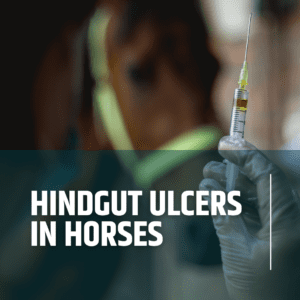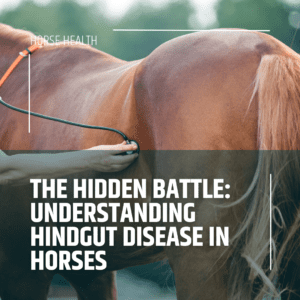What is the role of xylanase in a horse?
The role of xylanase in horses is to break down complex carbohydrates found in plant cell walls, particularly xylan, into simpler sugars that the horse can utilise for energy. This crucial process aids in the digestion of forage and hay, which constitute a significant portion of a horse’s diet (1). According to Hainze et al. (2003), xylanase facilitates the horse’s ability to extract vital nutrients and energy from these plant-based feeds, thereby contributing to their overall health, vigour and well-being (1).
How do horses produce xylanase?
Horses produce xylanase in their hindgut, which comprises the caecum and large colon, located after the small intestine in the digestive tract (2). As forage and hay traverse the horse’s digestive system, they ultimately reach the hindgut, where a diverse community of beneficial bacteria and other microorganisms synthesise xylanase. This enzyme then works to break down the complex sugars present in plant cell walls. The process not only releases simple sugars that the horse can absorb for energy but also supports the growth and proliferation of beneficial bacteria within the hindgut microbiome, fostering a symbiotic relationship between the horse and its gut flora (3).
How could supplementary xylanase help a horse’s digestion?
Supplementary xylanase can significantly enhance a horse’s digestion by providing additional enzymatic support to break down the complex carbohydrates found in plant cell walls (2). This supplementation can be particularly beneficial in aiding the digestion of forage and hay, which are essential sources of energy and fibre for horses (4). In instances where a horse may have a deficiency in their own production of xylanase, whether due to age, health conditions, or dietary factors, supplementary xylanase can play a crucial role in supporting their digestive health. By improving the breakdown of plant material, supplementary xylanase can potentially increase the horse’s ability to extract nutrients from their feed, leading to improved overall nutrition and digestive efficiency. A study conducted by Salem et al. (2015) supports that the addition of xylanase makes the oat straw more palatable and easier to digest for the animals. As a result, they consumed more of the feed and were able to extract more nutrients from it. This is significant because oat straw is often considered a low-quality feed due to its high fibre content and low digestibility. By using these enzymes, researchers were able to improve its nutritional value and make it a more effective feed source for animals (2).
Can xylanase help support a healthy microbiome in horses?
Indeed, xylanase can play a significant role in supporting a healthy microbiome in horses. The microbiome refers to the complex community of bacteria, fungi, and other microorganisms that reside in the horse’s hindgut (5). By effectively breaking down complex carbohydrates in plant cell walls, xylanase aids in the growth and proliferation of beneficial bacteria within the microbiome (6). This process helps maintain a balanced and thriving gut ecosystem, which is paramount for the horse’s digestive health and overall well-being. A healthy microbiome contributes to improved nutrient absorption, stronger immune function, and better overall digestive efficiency (5). Moreover, xylanase can assist in preventing the overgrowth of harmful bacteria in the hindgut, thereby reducing the risk of digestive disturbances and promoting a more stable gut environment (2).
Does EquiNectar contain xylanase?
Indeed, EquiNectar does contain xylanase. The source of this beneficial enzyme in EquiNectar is derived from sprouted barley grain, which serves as the primary constituent of the product. Sprouted barley is renowned for its natural abundance of xylanase, alongside other digestive enzymes (7). This method of incorporating xylanase into EquiNectar ensures that horses receive the enzyme in a natural, bioavailable form. The utilisation of sprouted barley as a source of xylanase aligns with the preference for natural ingredients in equine nutrition, potentially offering a more holistic approach to supporting digestive health in horses. The presence of naturally occurring xylanase in EquiNectar may contribute to its efficacy in promoting optimal digestion and nutrient absorption in equines.
References:
[1] Hainze, M., Muntifering, R., & McCall, C. (2003). Fibre Digestion in Horses Fed Typical Diets with and Without Exogenous Fibrolytic Enzymes. Journal of Equine Veterinary Science, 23(3), 111-115. https://www.researchgate.net/publication/248868922_Fiber_Digestion_in_Horses_Fed_Typical_Diets_with_and_Without_Exogenous_Fibrolytic_Enzymes
[2] Salem, A., Elghandour, M., Kholif, A., Odongo, N., Jimenez, F., Oca, R., Dominguez, I., & Dibarrat, J. (2015). The Effect of Feeding Horses a High Fiber Diet With or Without Exogenous Fibrolytic Enzymes Supplementation on Nutrient Digestion, Blood Chemistry, Fecal Coliform Count, and In Vitro Fecal Fermentation. Journal of Equine Veterinary Science, 35(9), 735-743. https://www.sciencedirect.com/science/article/abs/pii/S0737080615004657
[3] Wunderlich, G., Bull, M., Ross, T., Rose, M., & Chapman, B. (2023). Understanding the microbial fibre degrading communities & processes in the equine gut. Animal Microbiome, 5(3). https://animalmicrobiome.biomedcentral.com/articles/10.1186/s42523-022-00224-6#citeas
[4] Robinson, C., Nielsen, B., & Morris, R. (2007). Cellulase Supplementation Does Not Improve the Digestibility of a High-Forage Diet in Horses. Journal of Equine Veterinary Science, 27(12), 535-538. https://doi.org/10.1016/j.jevs.2007.10.014
[5] Weinert-Nelson, J. & Williams, C. (2023, August). The Equine Hindgut Microbiome. New Jersey Agricultural Experiment Station. https://njaes.rutgers.edu/e375/
[6] Smith, M. M., & Melrose, J. (2022). Xylan Prebiotics and the Gut Microbiome Promote Health and Wellbeing: Potential Novel Roles for Pentosan Polysulfate. Pharmaceuticals , 15(9), 1151. https://doi.org/10.3390/ph15091151
[7] Rico, D., Peñas, E., García, M. D. C., Martínez-Villaluenga, C., Rai, D. K., Birsan, R. I., Frias, J., & Martín-Diana, A. B. (2020). Sprouted Barley Flour as a Nutritious and Functional Ingredient. Foods (Basel, Switzerland), 9(3), 296. https://doi.org/10.3390/foods9030296





